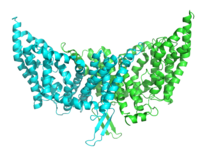From Wikipedia, the free encyclopedia
Multi-protein system
The bacterial phosphoenolpyruvate: sugar phosphotransferase system (PTS) is a multi-protein system involved in the regulation of a variety of metabolic and transcriptional processes. The PTS catalyzes the phosphorylation of incoming sugar substrates concomitant with their translocation across the cell membrane. The general mechanism of the PTS is the following: a phosphoryl group from phosphoenolpyruvate (PEP) is transferred to enzyme-I (EI) of PTS which in turn transfers it to a phosphoryl carrier protein (HPr). Phospho-HPr then transfers the phosphoryl group to a sugar-specific permease which consists of at least three structurally distinct domains (IIA, IIB, and IIC) [2] which can either be fused together in a single polypeptide chain or exist as two or three interactive chains, formerly called enzymes II (EII) and III (EIII). The IIC domain catalyzes the transfer of a phosphoryl group from IIB to the sugar substrate.
- ^ Cao Y, Jin X, Levin EJ, Huang H, Zong Y, Quick M, Weng J, Pan Y, Love J, Punta M, Rost B, Hendrickson WA, Javitch JA, Rajashankar KR, Zhou M (May 2011). "Crystal structure of a phosphorylation-coupled saccharide transporter". Nature. 473 (7345): 50–4. Bibcode:2011Natur.473...50C. doi:10.1038/nature09939. PMC 3201810. PMID 21471968.
- ^ Saier MH, Reizer J (March 1992). "Proposed uniform nomenclature for the proteins and protein domains of the bacterial phosphoenolpyruvate: sugar phosphotransferase system". Journal of Bacteriology. 174 (5): 1433–8. doi:10.1128/jb.174.5.1433-1438.1992. PMC 206537. PMID 1537788.

